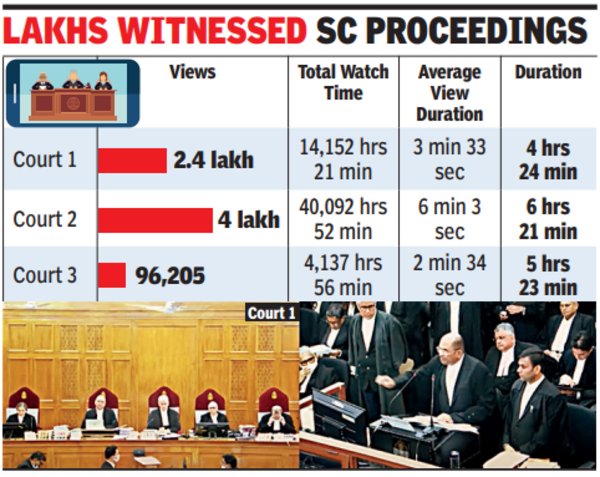Though only three Constitution bench proceedings were webcast on YouTube by the National Informatics Centre, there’s no doubt that all courtrooms will soon function under camera glare. With several media outlets also mirroring the feed on their YouTube channels, lakhs of people across the country were treated to a first-hand view of the apex court at work.
When the five-judge bench headed by CJI UU Lalit walked into Court No. 1 to conclude hearings on the EWS quota, three cameras, one focused on the judges and the other two on lawyers of opposing sides, started capturing the action.
In Court No. 2, the Justice DY Chandrachud-led bench heard the issues thrown up by the Shiv Sena split. In Court No. 3, the Justice Sanjay Kishen Kaul-headed bench was on the legal challenge to the All India Bar Examination.

SC livestreaming rare treat for students of law
On a day the Supreme Court ‘went live’, judges and lawyers seemed blissfully unaware of the live stream covering the three Constitution bench proceedings, far from apprehensions of the cameras dictating courtroom optics. Anyone expecting intense arguments were in for a disappointment. Lawyers plodded through their arguments in support and opposition to the EWS quota – marshalling history, judicial precedents, socio-economic realities and various quota policy decisions with the judges softly interjecting occasionally, for clarifications.
But keen students of law and citizens interested in keeping abreast with matters of public importance would have been delighted. Watching the likes of Attorney General KK Venugopal, Kapil Sibal, Abhishek Manu Singhvi, Tushar Mehta, Mohan Gopal, Meenakshi Arora and a host of other senior advocates press home their arguments is a rare treat. Meanwhile, senior advocate Kaleeswaram Raj joined the EWS hearing remotely, creating a sort of level playing field even for non-Delhi lawyers.
Interestingly, it is the high courts which took the lead in live streaming their proceedings. For months now, high courts of Odisha, Gujarat, Karnataka and a few others have been live-streaming proceedings out of all their courtrooms. From bail hearings to appeals against trial convictions, they arguably make for more compelling viewing from the human interest angle. In one Odisha HC hearing, a lawyer approaches Chief Justice S Muralidhar’s court seeking bail for a murder convict. The judge isn’t convinced, and asks the lawyer to argue the appeal against the conviction which unnerves the latter.
Since it started putting all orders online, live-streaming has been the next big judicial move towards transparency and open access. Courts make momentous decisions and it is only fair that citizens get to watch arguments on all sides and arrive at educated surmises on what views finally swayed the judges. With the public seeing the workings of a big public institution from close quarters, this is an online civics education, long after civics lessons from school may have been forgotten.
Tuesday’s streaming was smooth and glitch free, the credit for which goes to Justice D Y Chandrachud under whose leadership the e-committee of the Supreme Court has been striving hard to bring reform in the judicial sector by adoption of new technologies and the live streaming is one of them.
It has been exactly four years since the apex court had passed an order on September 26, 2018 and agreed to telecast the apex court’s hearings live and had also laid down the guidelines for its phased commencement. Favouring live-streaming, the court had said “sunlight is the best disinfectant and the live-streaming would reduce the public’s reliance on second-hand information and would help reduce misinformation and misunderstanding about the judicial process”.
“Live-streaming is a significant instrument of enhancing the accountability of judicial institutions and of all those who participate in the judicial process. Delay in the dispensation of justice is a matter of serious concern. Live-streaming of court proceedings will enable members of the public to know of the causes of adjournments and the reasons why hearings are delayed,” the court had said, while citing several reasons for which it must be done, including that it would “enhance the rule of law and promote better understanding of legal governance as part of functioning of democracy”.
Justice Chandrachud was part of the bench which passed the order in 2018.
In a separate order penned by him, Justice Chandrachud had said, “Access to justice can never be complete without the litigant being able to see, hear and understand the course of proceedings first hand. Apart from this, live-streaming is an important facet of a responsive judiciary which accepts and acknowledges that it is accountable to the concerns of those who seek justice. Live-streaming is a significant instrument of establishing the accountability of other stake-holders in the justicing process, including the Bar.”
Proceedings have mostly been open court, and in-camera hearing, though rarely, have also organised depending on the case, citizens have been facing accessibility problems. People were not able to witness hearings, particularly important constitutional matters which could have a bearing on their lives, because of several reasons including security threats and small size of courtrooms which is always packed with lawyers and have little space for the common man.
Also, it is a cumbersome process to get inside the courtroom as one has to get a pass from the administration for which recommendation of an advocate is required. Also, a limited number of passes is issued in view of the small size of courtrooms. With live-streaming, the litigants will no longer have to come to Delhi to witness proceedings of their case which would be just a click away.






